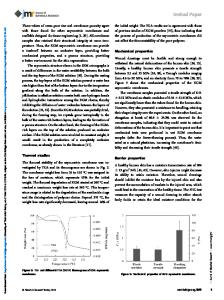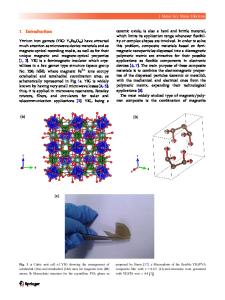Silk Fibroin/Poly (vinyl alcohol) Hydrogel Cross-Linked with Dialdehyde Starch for Wound Dressing Applications
- PDF / 888,835 Bytes
- 7 Pages / 595 x 842 pts (A4) Page_size
- 82 Downloads / 344 Views
Article www.springer.com/13233 pISSN 1598-5032 eISSN 2092-7673
Silk Fibroin/Poly (vinyl alcohol) Hydrogel Cross-Linked with Dialdehyde Starch for Wound Dressing Applications Pusita Kuchaiyaphum* Chatrachatchaya Chotichayapong Nutthaya Butwong Worapong Bua-ngern
Department of Applied Chemistry, Faculty of Sciences and Liberal Arts, Rajamangala University of Technology Isan, Nakhon Ratchasima 30000, Thailand Received December 12, 2019 / Revised March 30, 2020 / Accepted April 8, 2020
Abstract: Silk fibroin (SF) with the anti-bacterial property can be used in many fields including medical applications. However, the preparation of SF into a desired form is difficult due to its brittleness and compatibility. The purpose of this study was to prepare and characterize hydrogel containing SF and poly(vinyl alcohol) (PVA) crosslinked with dialdehyde starch (DAS) without the need for a conventional chemical crosslinker. The compatibility of SF and PVA, the gel fraction, and the swelling ratio of the SF:PVA hydrogel were improved when crosslinked with DAS. Moreover, the addition of DAS affected the porosity and the water vapor transmission rate (WVTR) of the hydrogel. The optimal ratio for preparation of the hydrogel was 50:50 SF:PVA with 5 wt% DAS, which exhibited a high gel fraction of 98 % and a 245-fold gel swelling compared with that of the dried hydrogel. The consequent loss of weight suggested the stability of hydrogel in water. The WVTR of the hydrogel was 2280±114 g·m-2·day-1 close to the range suitable for maintaining the appropriate fluid balance in the wound bed for wound healing without risking wound dehydration. The hydrogel improvement properties propose the potential to expanding the applications of SF:PVA hydrogels as wound dressing materials. Keywords: silk fibroin, poly(vinyl alcohol), dialdehyde starch, hydrogel, wound dressing.
1. Introduction Hydrogel is a 3D network structure obtained from several synthetic and/or natural polymers that can swell in water and hold a large amount of water while retaining its structure. The hydrogels from altered materials can be used in different applications such as counterfeit prevention, integrated optics, and biomedical engineering. Depending on the source, hydrogels can be synthesized through chemical and physical methods.1-5 Recently, the biomaterials obtained from renewable resources such as polysaccharides, lipids and proteins have been increasingly of interest according to an increase in the number of research publications due to their properties and environment-friendliness.6-10 Silk fibroin (SF) is a biodegradable natural protein polymer produced by Bombyx mori silkworms. SF displays excellent biocompatibility, outstanding mechanical strength, hemostatic properties, low inflammatory potential, permeability to oxygen and water vapor, and low immunogenicity. Moreover, SF has been approved for medical use by the U.S. Food and Drug Administration (FDA).11-14 Therefore, SF has been investigated as a starting material for the preparation of biomaterials for medical
Data Loading...











